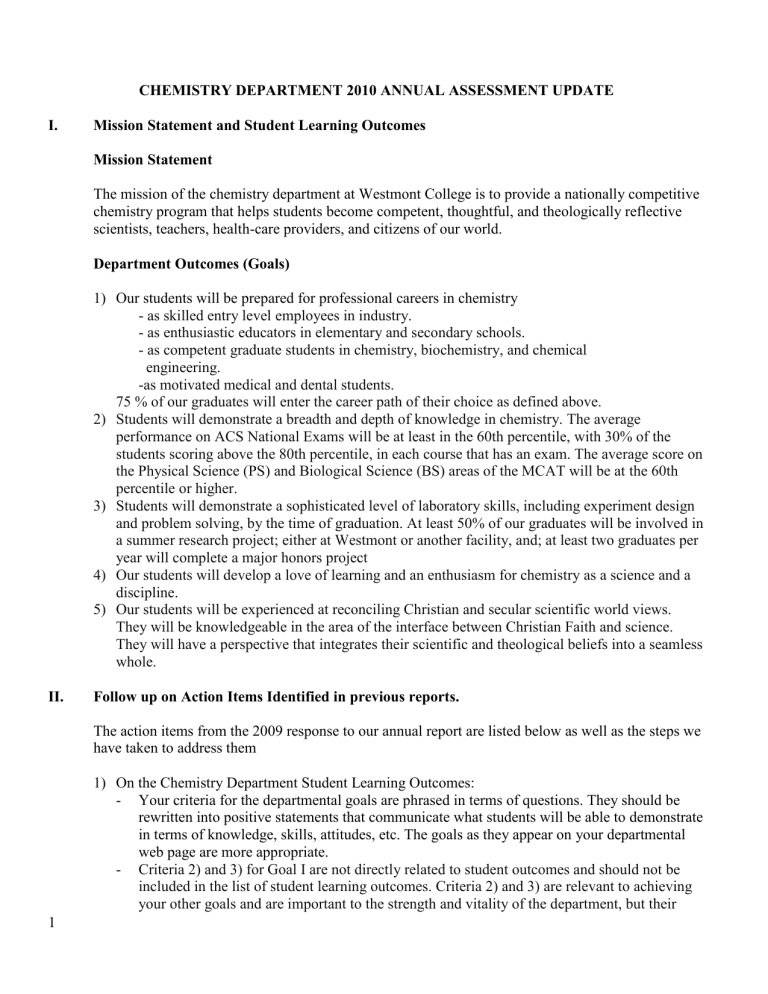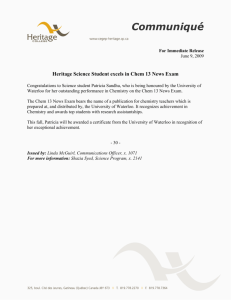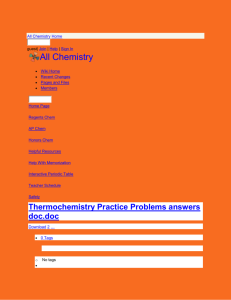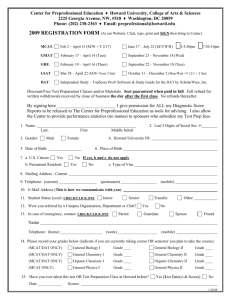2010ChemistryAnnualA..

CHEMISTRY DEPARTMENT 2010 ANNUAL ASSESSMENT UPDATE
I.
Mission Statement and Student Learning Outcomes
Mission Statement
The mission of the chemistry department at Westmont College is to provide a nationally competitive chemistry program that helps students become competent, thoughtful, and theologically reflective scientists, teachers, health-care providers, and citizens of our world.
Department Outcomes (Goals)
1) Our students will be prepared for professional careers in chemistry
- as skilled entry level employees in industry.
- as enthusiastic educators in elementary and secondary schools.
- as competent graduate students in chemistry, biochemistry, and chemical
engineering.
-as motivated medical and dental students.
75 % of our graduates will enter the career path of their choice as defined above.
2) Students will demonstrate a breadth and depth of knowledge in chemistry. The average performance on ACS National Exams will be at least in the 60th percentile, with 30% of the students scoring above the 80th percentile, in each course that has an exam. The average score on the Physical Science (PS) and Biological Science (BS) areas of the MCAT will be at the 60th percentile or higher.
3) Students will demonstrate a sophisticated level of laboratory skills, including experiment design and problem solving, by the time of graduation. At least 50% of our graduates will be involved in a summer research project; either at Westmont or another facility, and; at least two graduates per year will complete a major honors project
4) Our students will develop a love of learning and an enthusiasm for chemistry as a science and a discipline.
5) Our students will be experienced at reconciling Christian and secular scientific world views.
They will be knowledgeable in the area of the interface between Christian Faith and science.
They will have a perspective that integrates their scientific and theological beliefs into a seamless whole.
II.
Follow up on Action Items Identified in previous reports.
The action items from the 2009 response to our annual report are listed below as well as the steps we have taken to address them
1) On the Chemistry Department Student Learning Outcomes:
Your criteria for the departmental goals are phrased in terms of questions. They should be rewritten into positive statements that communicate what students will be able to demonstrate in terms of knowledge, skills, attitudes, etc. The goals as they appear on your departmental web page are more appropriate.
Criteria 2) and 3) for Goal I are not directly related to student outcomes and should not be included in the list of student learning outcomes. Criteria 2) and 3) are relevant to achieving your other goals and are important to the strength and vitality of the department, but their
1
evaluation should take place as part of the six-year program review in the section on departmental capacity and resources. They should not be included in the list of student learning outcomes.
We have addressed each of these concerns in section I above. We have rewritten our criteria as statements and renamed them outcomes to reflect the change. We have also eliminated criteria 2) and 3) as requested, and reorganized our goals into five outcomes.
2) On Planning for and Reporting on Departmental Assessment:
Each Annual Assessment Update should include a timeline for assessment between now and your six-year Program Review. The plan should be structured so that each of your departmental objectives receives attention before the six-year Program Review Report is due.
(The need for such a schedule was pointed out in the response to your six-year report.)
In particular, you should not be assessing and reporting on all of your objectives every year.
As you correctly note in your report, the small numbers of Chemistry graduates will make yearly results from the ACS subject exams quite variable. So gather the data each year, but rotate through your student learning outcomes discussing and reporting on the accumulated data for each one about once every three years.
Our proposed schedule is as follows:
2010 – Focus on outcome 5)
2011 – Focus on outcome 1)
2012 – Focus on outcome 2)
2013 – Focus on outcome 3) and 4)
When reporting on data gleaned from essays, include the prompt and the evaluation rubric as appendices. In the body of the report, identify the number of essays involved and the number of essays that were judged according to the rubric to fall into the various proficiency levels.
When using student participation as a measure of engagement, report the numbers or percentages of students participating.
We have addressed these concerns in section III below.
III.
2010 Focus
A) Our 2010 focus is outcome 5) which reads: Our students will be experienced at reconciling
Christian and secular scientific world views. They will be knowledgeable in the area of the interface between Christian Faith and science. They will have a perspective that integrates their scientific and theological beliefs into a seamless whole. We have assessed this outcome by having our students who are enrolled in CHM 195 (chemistry seminar) write on the following prompt: Describe the relationship between your work as a scientist and your life as a Christian.
Ten student essays were evaluated. The graded essays are stored in the chemistry department assessment archive under Assessment Data\2010 Student Essays. The rubric used to grade the essays by two departmental readers (Tro and Contakes) is shown below.
2
3
Poor (2 pts) Satisfactory (5 pts)
Excellent (8 pts)
Outstanding
(10 pts)
Overall Writing
Quality (Is the response well-written?)
Jumbled, wordy.
Many grammatical errors.
No main thesis.
Wordy, but not jumbled. Few grammatical errors
Coherent, concise. No grammatical errors.
Clear, concise, beautifully written. No grammatical errors.
Strong, clearly stated, thesis.
Main Thesis (Does the response have a central clear idea about how the student’s work as a scientist and his or her life as a Christian integrate with or relate to one another?)
Contains a main idea, but main idea is weak.
Cogent, clearly stated thesis.
Support and Focus
(Does the body of the paper support the main idea or does it wander into irrelevant material?)
Maturity and Depth of Thought (Is the student’s thinking at a mature level? Have they thought deeply about how these two parts of their lives fit
Body does not support the main idea.
Ideas are immature and characteristic of those who have not thought
Body moderately supports the main idea, but contains extraneous material.
Ideas are okay and show some prolonged engagement with the topic.
Body supports main idea.
Ideas are strong and show prolonged engagement with the topic.
Body clearly and convincingly supports the main idea.
Ideas are mature and well developed. The student has clearly thought about this a great deal. integrate into a seamless whole>) deeply about the topic.
8 points total
20 points total 32 points total
40 points total
Out of 10 papers, the average grade is 27.7 points, which is between Satisfactory and Excellent.
The range is from 21-34 pts.
B) The department discussed the results of the student essays at our department meeting on
September 7, 2010. We decided that, although the average of the essay scores was clearly above the satisfactory level, we would like a bit more from our students. We set a score of 32
(excellent) as our goal. The assessment method was deemed satisfactory.
C) We felt that students could perform better with respect to our assessment rubric if the expectations for the essays had been more clearly explained to them. In order to meet our revised goal, we decided that students should have two or three opportunities throughout the chemistry seminar course (CHM 195) to write essays of the type used at the end of the semester for assessment. In particular, students should be given the rubric at the beginning of the semester, and these essays should be graded according to the rubric so that students get a better sense of the expectations.
IV.
Next Steps
A) Next year, we will focus on outcome 1. In our meetings, we continue to track our graduates and their current careers in order to assess outcome 1.
B) In 2012, will focus on outcome 2. To that end, we continue to administer and track the results of the American Chemical Society subject exam and of our student’s MCAT scores.
The current data is included in appendix A).
C) In order to prepare for a more careful evaluation of our summer research program, we have added an appendix (appendix B) that lists those students involved in summer research. In addition, we have prepared a questionnaire to be administered to our summer research students at the end of their summer research experience. We will administer that questionnaire for the first time to those students who participated in summer research during the summer of 2010.
Appendices:
A) ACS Exam Results and MCAT Data
B) Summer Research Students
4
Appendix A
Spring 09
Gen. Chem.
Gen Chem
Organic
Analytical
P.Chem.II
Inorganic
5
Data for Outcome 2: Chemical Knowledge
American Chemical Society National Subject Exams
We continue to track our student’s chemical knowledge through the administration of the national
American Chemical Society subject exams. The results from the last three years are shown below.
American Chemical Society National Exam Results
Percentiles based on National Norms
Spring 10
Course
Number
Number of
Students
%Tile
Std.
Dev.
Range
Above
80%tile
Percent above
80%tile
Gen. Chem.
Gen Chem
Organic
Analytical
P.Chem.II
6 Honors
6A&B
Combined
102
121
131
20
68
88
48
16
2
79
42
50.4
49
79
60
19
25.4
23.9
27
23
3
25-100
0-94
0-100
1-100
26-100
13
4
17
8
7
0
65%
10%
19.3%
17%
44%
0%
Course
Number
American Chemical Society National Exam Results
Percentiles based on National Norms
Number of
Students
%Tile
Std.
Dev.
Range
Above
80%tile
6 Honors
6A&B
Combined
102
121
131
104
15
70
85
36
13
4
9
73
49
53.2
63
85
66
83
25
10
12.6
24
23
8.6
24
27-98
1-100
1-100
6-99
22-100
58-78
36-99
8
11
19
9
10
0
4
Percent above
80%tile
53%
16%
22%
25%
77%
0%
44
Spring 08
Gen. Chem.
Gen Chem
Organic
Analytical
P.Chem.II
Course
Number
American Chemical Society National Exam Results
Percentiles based on National Norms
Number of
Students
%Tile
Std.
Dev.
Range
6 Honors
6A&B
Combined
102
121
131
33
49
82
31
17
5
85
50
64.1
64
64
45
14
26
21.2
23
24
6
48-100
3-99
3-100
31-98
9-96
42-59
Above
80%tile
23
8
31
9
7
0
Spring 07
Course
Number
Gen. Chem. 6 Honors
6A&B
Gen Chem Combined
Organic
Inorganic
Analytical
P.Chem.II
102
104
121
131
American Chemical Society National Exam Results
Percentiles based on National Norms
Number of
Students
22
58
80
43
8
9
2
%Tile
79
63
67.3
43.2
47
77
76
Std. Dev.
19.3
26
26
24
31
19
-
Range
45-99
10-98
10-99
1-87
7-93
41-98
57-94
Above
80%tile
14
22
36
3
1
5
1
Percent above
80%tile
70%
16%
38%
29%
41%
0%
Percent above
80%tile
63%
37%
45%
7%
12%
55%
50%
6
Medical College Accept Tests (MCAT)
The MCAT data for our graduates last year is shown below
MCAT Data
MCAT Exam Results: 01-Jul-2009 through 30-Jun-2010
Total
MCAT Section
Verbal Reasoning
Mean
9.5
Physical Sciences 10.4
Biological Sciences 10.4
MCAT Section Median
Writing Sample P
MCAT Section Mean
30.3P
N=24
Std Dev
1.68
1.89
1.78
25th / 75th %ile
M / Q
Std Dev
4.44
Westmont
Percentage of Students with Scores
1-4 5-6 7
0 4 17
0
0
4
0
0
4
J-K L-M N
8
4
13
17
O
9 10-11 12-15
13
8
8
P
58
46
46
4
29
25
Q-R S-T
4 29 4 4 21 38 0
3-7 8-12 13-17 18-22 23-25 26-28 29-31
0 0 0 4 13 13
32-
35
36-
40
41-
45
21 38 13 0
MCAT Section
Verbal Reasoning
Physical Sciences
Biological Sciences
MCAT Section
Writing Sample
MCAT Section
Total
National
N=82848
Mean Std Dev
8.0
8.3
2.48
2.48
8.8 2.53
Median 25th / 75th %ile
O M / Q
Mean
25.1O
Std Dev
6.43
Percentage of Students with Scores
1-4 5-6 7 8 9 10-11 12-15
9 20 10
5 19 19
7 12 7
J-K L-M N
14 15
14 12
27
21
4
11
15 15
O P
33
Q-R
11
S-T
4 27 9
3-7 8-12
13-
17
13
18-22
10
23-
25
33 5
26-28 29-31
32-
35
36-
40
41-
45
0 3 9 19 19 18 15 12 4 0
Percentiles 7/09-6/10
Count verbal
24 67.4
Physical Sci.
68.1
Writing Sample
49.6
Biological Sci.
65.7
Total
69.8
7
MCAT Exam Results: 01-Jul-2008 through 30-Jun-2009
Group
Examinees - All
MCAT Section
Verbal Reasoning
Physical Sciences
Biological Sciences
MCAT Section
Writing Sample
MCAT Section
Total
Mean
9.4
8.7
9.5
Median
P/Q
Mean
27.6P/Q
N=
Std Dev
Westmont
28
Percentage of Students with Scores
1-4 5-6 7 8 9
10-
11
12-
15
2.02 4 7 0 18 11 57 4
1.98 0 7 29 18 11 25 11
2.21 4 4 7 7 25 39 14
25th / 75th %ile J-K L-M N O P Q-R S-T
M / Q 0 32 7 7 4 46 4
Std Dev 3-7 8-12
13-
17
18-
22
23-
25
26-
28
29-
31
32-
35
36-
40
41-
45
5.09 0 0 4 11 18 29 21 11 7 0
Group
Examinees - All
MCAT Section
Verbal Reasoning
Physical Sciences
Biological Sciences
MCAT Section
Writing Sample
MCAT Section
Total
Mean
National
N=
79088
Std Dev
Percentage of Students with Scores
1-4 5-6 7 8 9
10-
11
12-
15
8.0
8.2
2.47 10 19
2.44 5 19
10
18
16
14
16
13
26
20
4
10
8.7 2.54 7 12 7 16 16 32 11
Median 25th / 75th %ile J-K L-M N O P Q-R S-T
Mean
O
24.9O
M / Q 3 28 9 13 10 31 6
Std Dev 3-7 8-12
13-
17
18-
22
23-
25
26-
28
29-
31
32-
35
36-
40
41-
45
6.42 0 3 9 20 18 18 16 11 4 0
Percentiles 7/08-6/09
Count verbal
28 64.8
Physical Sci.
56.2
Writing Sample
56.1
Biological Sci.
56.8
Total
60.0
8
Appendix B
SUMMER RESEARCH STUDENTS
2004
Jonathan Brigham
Alanna Engle
Tim LeDoux
Julie Ray
Jon Rea
Carrie Stein
Currently
St. Louis U. - medicine
RN/BSN 2007
Grad School UCSB (Chem)
Teacher
UCSB teaching credential
Instructor –Westmont Chemistry Dept.
2005
Jon Burdett
Michelle Evans
Daniel Hoss
Katie Howard
April Louie
Julie Ray
2006
Grad School UCRiverside (Chem)
Grad School Michigan St. U. (Chem)
M. D.- Loma Linda grad. 2010
Grad School Portland St. (Psych)
Grad School Hawaii (Chem)
Teacher
Gregory Allen
Angela Mayfield
Michelle Evans
Grad School UC Davis (Chem)
Forensic Chemist, Oregon Crime Lab
Grad School Michigan St. U.
2007
Michael Bootz
Kyle Godfrey
Melissa Gross
Benjamin Murray
Midwestern AZ – Med School/DO
Georgetown U. – Med School
Applying to Grad School; working in a lab in SB
Applying to Medical School
Roberto Valladares Stanford Medical School
2008
Christine Binkley Applying to Med School
Wm. Ben Farnsworth Applying to Med School
Melissa Gross
Michelle Haas
Wendi Hale
Brittany Hammer
Working in Analytical Lab/Applying to Grad School
Senior at Westmont College
Grad School Univer. Michigan (Chem)
MPH online program/Applying to Med School
Taylor Judkins
Cherol Tomer
Blake Winn
Grad School UCSB (Chem)
High School Chemistry teacher
Grad School Baylor University (Chem)
2010
Lauren Bernau
Bryan Brautigam
Kelsey Cannon
Dayna Chang
Sr. Westmont – Applying to Med School
Sr. Westmont – Applying to Grad School (neuroscience)
Jr. Westmont College
Jr. Westmont College
Samantha Gardner Sophomore Westmont College
Ashley Greenawalt Jr. Westmont College
Michelle Haas
Jeff Kuwahara
Laura Selby
Sr. Westmont – plans to be a missionary Pakistan
Sr. Westmont – Applying to Med School
Sr. Westmont – Applying to Med School
Hannah Sievers Jr. Westmont College
9






